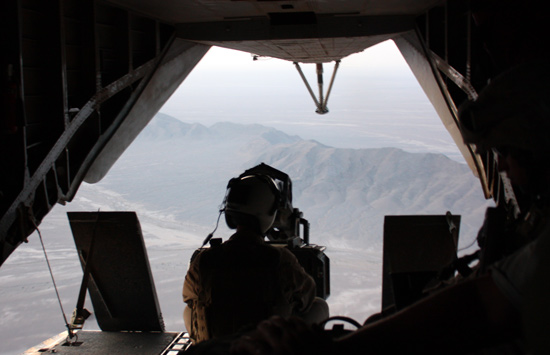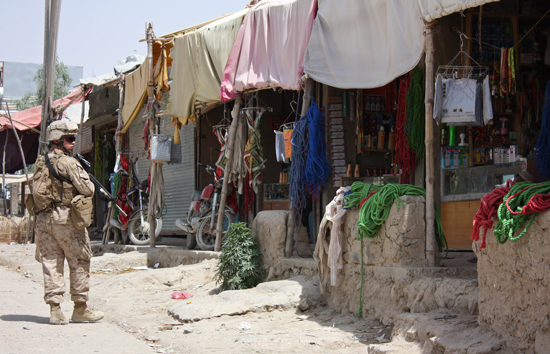|
|
|
The view from the back of a CH-53 Super Stallion helicopter, en route from Camp Leatherneck to Delaram. Photo by Bill Ardolino for LWJ. |
I’m currently embedded with the 1st Battalion, 2nd Marines, in Musa Qala, Helmand province, Afghanistan. After traveling through JFK, Frankfurt, Kabul, Camp Leatherneck, and Delaram, I’ve finally settled in. Several pieces are in the works, but here are some first impressions of Musa Qala.
Security is variable, hinging on how far one moves from the District Center (DC). The DC can be very roughly described as ‘downtown,’ since it contains government buildings, the densest press of people and brick and mud-daub structures, and the district’s sole legal bazaar. The remainder of the district stretches north and south in a kidney-shaped area of small villages, farms, and individual compounds littered along the wadi.
Within the DC itself, and a roughly 16 x 5 kilometer area stretching north-south, security is surprisingly good, given the area’s famously kinetic history under British responsibility. It seems that UK forces succeeded in calming down the center of Musa Qala after ISAF forces reclaimed the area during Operation Snake Pit in December 2007. Their March 2010 replacement with a larger number of US Marines, plus increased capability by the Afghan National Security Forces (ANSF), have built on this progress. Threats of attack remain omnipresent, but a high tempo of patrols and ongoing fighting in other portions of the district seem to have solidified the security envelope. Shootings have become rare, and the last time a bomb went off in or near the bazaar was in April.
The northern and southern ‘suburbs’ remain extremely contentious, however. When the Marines arrived, they expanded ISAF lines by clearing the northern village of Karamanda and Salaam Bazaar to the south (actually in neighboring Now Zad District) in a short burst of intense fighting. Insurgents inevitably licked their wounds and switched tactics, now favoring roadside bombs and hit and run attacks against Marines and ANSF forces. IEDs are particularly common, and remain the greatest security threat. On a positive note, the exclusive use of at least two classes of heavily-armored Mine Resistant Ambush Protected (MRAP) vehicles is saving lives – insurgent bombs can sometimes take out a vehicle, but rarely kill the occupants. The Marines also conduct a lot of foot patrols, however, so remote-controlled bombs are claiming some lives within Musa Qala and in the Battalion and Regimental Combat Team’s larger area of operations. Regarding the latter, it’s important to note that the British Royal Marines under US command have it exceptionally tough in neighboring Sangin District to the east of Musa Qala.
Despite the ongoing fighting and some significant political and developmental challenges, I get the sense that the Marines are making progress. At the very least, all of the complementary wheels of counterinsurgency are in motion. Commanders and junior officers here largely understand and embrace the doctrine, though only time will tell if fortune, the nature of local ‘unknown unknowns,’ and US political will can grant the strategy the space it needs to succeed.
The conflict in Helmand is exceedingly complex. Before providing extended commentary I will need many more patrols and interviews under my belt. But some standout impressions are shaping the coverage thus far. Positives: USMC culture and counterinsurgency doctrine, and the well-reviewed capability of some Afghan National Security Forces in the region, specifically within Musa Qala. (Very big) Negative: the opium economy and its symbiotic link to instability. More to follow.
|
|
|
A Marine with Headquarters and Service Company, 1st Battalion, 2nd Marines, patrols the bazaar in Musa Qala. Photo by Bill Ardolino for LWJ. |
Are you a dedicated reader of FDD's Long War Journal? Has our research benefitted you or your team over the years? Support our independent reporting and analysis today by considering a one-time or monthly donation. Thanks for reading! You can make a tax-deductible donation here.










5 Comments
Thanks LWJ and Bill(s) for providing this excellent resource!
Bill,
It is good to hear you reporting again from a war zone. I look forward to your unvarnished analysis in the future as there has been a very limited amount of first hand reporting on the actual conditions on the ground in this conflict.
What Rosario said! You photo slide show was terrific. Thank you. Looking forward to more.
Thanks for the being there and the well written overview. Please tell the Grunts Semper Fi – we are all proud of their work.
To assist your readers could you print the Lat/Long of some of these villages so that we could follow you on Google Earth?
Stay Safe.
Bill,
Thanks for going out to Indian country. My son is with the 1/2 Charlie Company 4th platoon. You wrote a GREAT article on them. Thank you for keeping us informed.
We love our Marines.